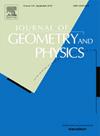给定期望值密度矩阵的偏序和拓扑及量子Choquet积分
IF 1.2
3区 数学
Q1 MATHEMATICS
引用次数: 0
摘要
研究了d×d厄米矩阵(可观测值)的集M作为一个偏序集,其偏序为Löwner。其中的上下集合定义了厄米矩阵中累积性(主要用于标量量)的概念。偏序与拓扑密切相关,并将厄米矩阵的集合M作为拓扑空间来研究,其中开集和闭集分别为上集和下集。证明了厄米矩阵的集合M是一个T0拓扑空间,其密度矩阵的子集D是Hausdorff完全不连通拓扑空间。这些思想是研究厄米矩阵的量子Choquet积分(与标量的经典Choquet积分相反)的先决条件。容量(非加性概率),涉及厄米矩阵的累积量,以及消除非可交换观测值之间重叠的Möbius变换,用于量子Choquet积分。该形式的一个应用是找到一个密度矩阵,该矩阵对n个(不可交换)可观测值具有给定的期望值。给出了计算这种密度矩阵的例子(在其期望值中有量化误差)。本文章由计算机程序翻译,如有差异,请以英文原文为准。
Partial order and topology of Hermitian matrices and quantum Choquet integrals for density matrices with given expectation values
The set M of Hermitian matrices (observables) is studied as a partially ordered set with the Löwner partial order. Upper and lower sets in it, define the concept of cumulativeness (used mainly with scalar quantities) in the context of Hermitian matrices. Partial order and topology are intimately related to each other and the set M of Hermitian matrices is also studied as a topological space, where open and closed sets are the upper and lower sets. It is shown that the set M of Hermitian matrices is a topological space, and its subset of density matrices is Hausdorff totally disconnected topological space. These ideas are a prerequisite for studying quantum Choquet integrals with Hermitian matrices (as opposed to classical Choquet integrals with scalar quantities). Capacities (non-additive probabilities), cumulative quantities that involve Hermitian matrices, and Möbius transforms that remove the overlaps between non-commuting observables, are used in quantum Choquet integrals. An application of the formalism is to find a density matrix, with given expectation values with respect to n (non-commuting) observables. Examples of calculations of such a density matrix (with quantified errors in its expectation values), are presented.
求助全文
通过发布文献求助,成功后即可免费获取论文全文。
去求助
来源期刊

Journal of Geometry and Physics
物理-物理:数学物理
CiteScore
2.90
自引率
6.70%
发文量
205
审稿时长
64 days
期刊介绍:
The Journal of Geometry and Physics is an International Journal in Mathematical Physics. The Journal stimulates the interaction between geometry and physics by publishing primary research, feature and review articles which are of common interest to practitioners in both fields.
The Journal of Geometry and Physics now also accepts Letters, allowing for rapid dissemination of outstanding results in the field of geometry and physics. Letters should not exceed a maximum of five printed journal pages (or contain a maximum of 5000 words) and should contain novel, cutting edge results that are of broad interest to the mathematical physics community. Only Letters which are expected to make a significant addition to the literature in the field will be considered.
The Journal covers the following areas of research:
Methods of:
• Algebraic and Differential Topology
• Algebraic Geometry
• Real and Complex Differential Geometry
• Riemannian Manifolds
• Symplectic Geometry
• Global Analysis, Analysis on Manifolds
• Geometric Theory of Differential Equations
• Geometric Control Theory
• Lie Groups and Lie Algebras
• Supermanifolds and Supergroups
• Discrete Geometry
• Spinors and Twistors
Applications to:
• Strings and Superstrings
• Noncommutative Topology and Geometry
• Quantum Groups
• Geometric Methods in Statistics and Probability
• Geometry Approaches to Thermodynamics
• Classical and Quantum Dynamical Systems
• Classical and Quantum Integrable Systems
• Classical and Quantum Mechanics
• Classical and Quantum Field Theory
• General Relativity
• Quantum Information
• Quantum Gravity
 求助内容:
求助内容: 应助结果提醒方式:
应助结果提醒方式:


